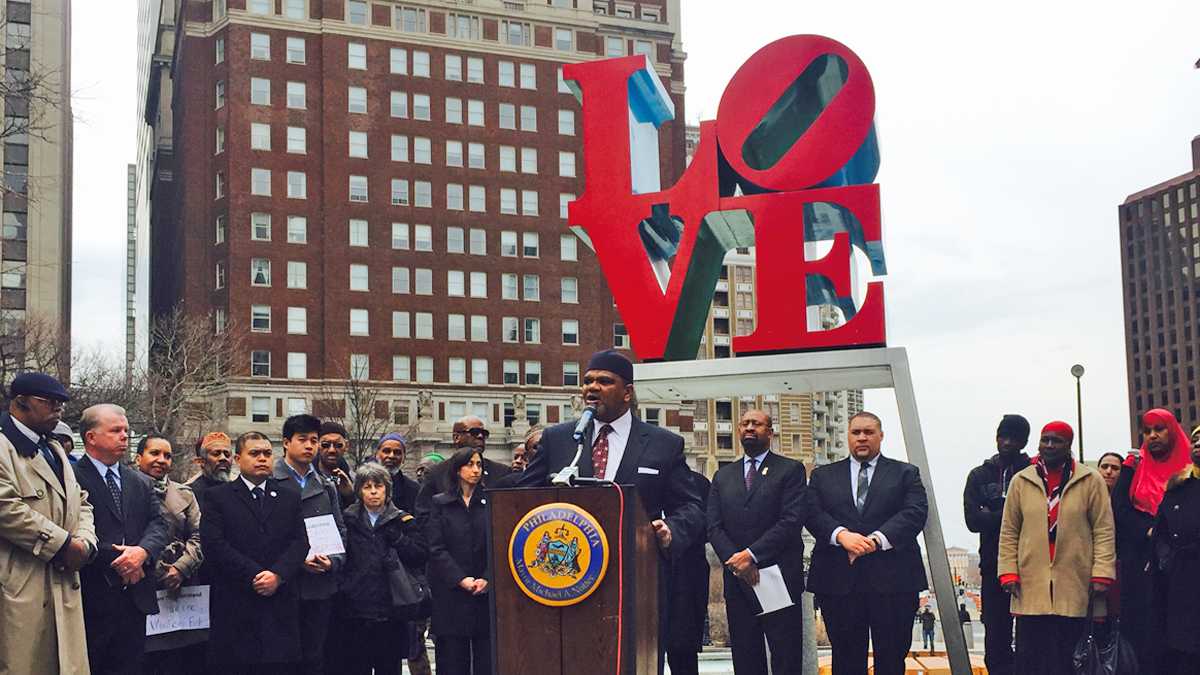Anti-Muslim ads create an opportunity to replace hate with understanding

Imam Mikal Shabazz is shown on March 31 encouraging listeners not to blame SEPTA for anti-Muslim ads. (Bobby Allyn/WHYY, file)
The recent ruling allowing the American Freedom Defense Initiative to run a four-week ad campaign of anti-Muslim ads on SEPTA buses, the question of how to handle free speech in an increasingly diverse culture has become literally visible, both in the ads themselves and in the counter-voice of the Dare To Understand campaign.
Religious freedom, freedom of speech, and civil rights are concepts that have been tricky to balance in American social history — and sometimes even tricky to tell the difference between. But these days, especially in light of laws like Indiana’s version of the “Religious Freedom Restoration Act,” these rights can feel like nothing less than a traffic jam.
And of course, no less right in our own backyard. With the recent ruling by Judge Goldberg of the United States District Court for the Eastern District of Pennsylvania granting the American Freedom Defense Initiative (AFDI) a preliminary injunction to run a four-week ad campaign of anti-Muslim ads on SEPTA buses, the question of how to handle free speech in an increasingly diverse culture has become literally visible, both in the ads themselves and in the counter-voice of the Dare To Understand campaign.
The visuals intersect with the work lives of Philadelphians in several ways, including the pathways to work and what you’d envision for support for diversity in the city’s work life.
I called Andrew Feigenbaum, program and communications associate, Interfaith Center of Greater Philadelphia (the organization leading Dare To Understand), for some perspective on how it came together for him.
He graduated from the University of Notre Dame Law School this past May and received his undergraduate degree from the University of Pennsylvania in 2009.
Feigenbaum fell into interfaith work through his love of working on behalf of kids. While an undergraduate at Penn, he was president of Legal Voices for Children.
“I knew coming out of law school I didn’t know if I wanted to practice right away; I wanted to do more people work — to interact, especially work with kids. I’m passionate about that. In high school, I helped create reading programs for kids, and at City Hall, I did Philadelphia Reads. The program aspect of my job at the Interfaith Center drew me, like the programs Walking the Walk, and Alternate Breaks. They’re really great experiences.”
Still, working with kids is one thing, and taking on the religious aspect of diversity is even more specific, especially in a diverse place like Philadelphia. “I’ve been a practicing Roman Catholic since I was born,” he says, “though after meeting the people that we work with each day, I’m certainly not the most devout. But I like the learning experience of diverse faiths, ethnic and racial backgrounds. That was important for me.
“It was exciting to see the kind of work the Center does. You see in the media every day these negative images, like the Westboro Baptist Church and others using religion the wrong way. Or you see people disparaging people of faith. The issue seems divisive and like it’s holding our society back.”
Becoming an employee at the Interfaith Center let him both serve and learn at the same time. “I hadn’t had a huge amount of background in religion so I was like an employee-participant. Like in the program Alternative Breaks, I got to visit [Sikh] gurdwaras, Buddhist temples. It was a conscious learning experience while doing work in the community.”
And that learning took on a faster speed with the recent ruling allowing the “free speech” of the SEPTA ads — and at the same time, that’s where Feigenbaum’s background in law became even more of an unexpected asset.
“My law background has been a boon to the organization,” he says, “with the SEPTA battle and trademark filings and contracts and release forms, having a lawyer on staff is helpful. To understand the ruling for SEPTA and fold those issues into the work the Center does — it’s a random skill that ended up being useful. It gives me the ability to speak about issues we come up to every day.”
When I asked him what he’d especially noticed, as a lawyer and advocate, in the unfolding story around the SEPTA ruling, Feigenbaum came up with a lovely twist.
“I was looking up quotes from my Freedom of Speech class in law school, and came across a quote by Justice Louis Brandeis basically, ‘When there’s bad speech, the remedy is better speech.'”
If there be time to expose through discussion the falsehood and fallacies, to avert the evil by the processes of education, the remedy to be applied is more speech…Concurring, Whitney v. California, 274 U.S. 357 (1927)
“That’s what this came down to for the SEPTA/AFDA thing,” Feigenbaum says. “Look, I am a staunch supporter of our freedom of speech, and if the decision was that they had the right, at least for now, to post these ads, it provides an opportunity to offer that ‘better speech,’ that other voice that can respond to these issues because they’ve given us that platform. It’s probably not their intention. These ads serve to divide and spread hate. It gave us a great opportunity to talk about our message.
“Our tag line is to take a chance, be curious,” he says. “Like on Alternative Break, to go to a Buddhist temple and try the meditation chant, and yoga, and learn a new tradition. Or going to the gurdwaras and sharing the meal they provide to any visitor who comes to the temple — it was amazing. It lets us become better citizens of the world.”
So it was cool we were able to transcend these messages of hate to be more assertive in doing something good — the billboards, training sessions, things to help educate people and let them try new things, and all because of the bad speech that let us put the good speech out there.
WHYY is your source for fact-based, in-depth journalism and information. As a nonprofit organization, we rely on financial support from readers like you. Please give today.




